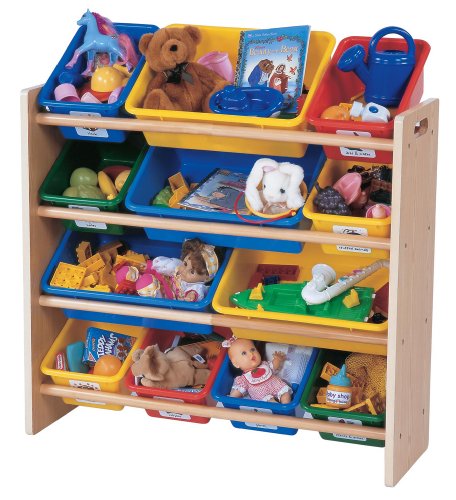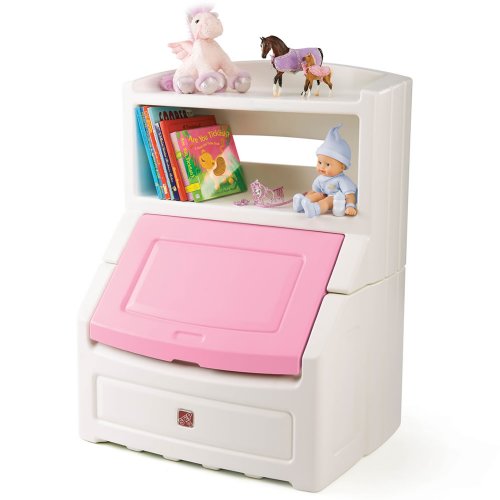When deciding to add a new wireless intercom system to the ever increasing portfolio of wireless devices in your home or business, you need to first think about the compatibility with the products you already have (or your close neighbors have). You also need to consider the range and features you need.
Toy Room Storage
Wireless Intercom Frequencies
Toy Room Storage
In the United States there are several frequency ranges for wireless products for unlicensed consumer use. They are 49MHz, 900MHz, 2.4GHz, 5.8GHz, and Family Radio Service (FRS) band. Most recently the FCC added the Multi-Use Radio (MURS) service. Radio frequencies for devices are similar in Canada, but MURS cannot be used there.
Back when consumer wireless products were first introduced, these wireless products used the 49MHz frequency spectrum. Early cordless telephones used this spectrum and it is still used by cheap baby monitors and other low-end wireless units. It has a short range and is prone to lots of interference. You won't likely find wireless intercom systems that use this spectrum anymore, or if you do, you won't want them.
Later, 900 MHz products using analog transmission technology arrived on the market. Neither the 49MHz or these early 900Mhz products have any form of security. Anyone with a device in the same frequency can listen in to conversations. Newer digital spread spectrum 900MHz products divide digital transmission across a range of frequencies so other devices can't eavesdrop on your conversations. Digital spread spectrum intercoms also have a greater range than the analog 900Mhz units. There are at least two wireless intercoms currently on the market, but only one of them uses digital spread spectrum. The wireless intercom system that uses spread spectrum can communicate up to 1000 feet.
2.4GHz devices were next to market. There are a growing number of cordless telephones and other devices in this range. As far as intercom systems, video intercom systems are the primary users of this range although the only wireless video intercom on the market was recently discontinued. 2.4GHz is also the frequency range used by WiFi wireless data networks (802.11B/G) in homes and businesses so products in this range can interfere with each other.
The Family Radio Service (462-467MHz) is in the Ultra High Frequency (UHF) band and is basically an improvement to the old walkie talkies of long ago. These handheld radios are sold everywhere and used heavily so any intercom systems in this range would have to compete with these handheld radios (and anyone can listen in to your conversations). There are no known wireless intercoms systems that use FRS.
Now 5.8GHz products are starting to make their appearance in the cordless phone arena. No compatibility issues exist between 5.8GHz and 2.4GHz devices so no problems should be experienced in mixing them. However, there are currently no known wireless intercom systems in this range.
You'll also see some intercom systems that claim to be wireless but they really use the power wiring in your home or business to send and receive transmissions from the intercom. These are frequently called "FM wireless intercoms" even though they often transmit over your house wiring in the AM band. To use them, you just plug an AC adapter into the wall. These systems are very prone to humming or buzzing and are not recommended unless you are prepared to live with this possibility. Since house wiring comes in as 240 volts and is split in two phases of 120, you'll also experience problems with the signal trying to cross the phases. One part of your house or business may work fine, where the other half doesn't. These intercoms are typically the least expensive intercoms of the bunch.
Long Range Wireless Intercoms
The most recent addition to the wireless intercom market are products in the MURS frequency range. MURS is a service in the VHF (Very High Frequency) 150 MHz radio spectrum. MURS has a power increase of four times that of FRS radio. And unlike FRS, you can add a larger or external antenna to improve range. If you want to put an antenna on top of your house, you can do it with MURS. Some antenna manufacturers claim an external antenna can increase the effective radiated power of a transmitter by a factor of 4. These MURS intercoms can transmit up to four miles, and perhaps more with an external antenna.
The Federal Communications Commission (FCC) in the United States does not require you obtain a license to use MURS frequencies so you will not have to go through that process.
There are 5 MURS channels and 38 interference eliminator or "quiet codes" that can be used on each of these channels. These quiet codes keep your radios quiet unless another radio is programmed on the same channel and quiet code. Chances are you won't have to worry about these codes since MURS usage is extremely light. There are only a few makers of MURS radios, so traffic on these frequencies is hard to find in most areas.
The MURS Intercom system is the wireless intercom you need if you have a large property or you need to talk between buildings. You can use a MURS to not only communicate within a home, but to neighboring homes as well. You can even add a handheld unit to your MURS intercom system so you can stay in touch away from your home.
Long Range Wireless Outdoor Intercoms
You can also get commercial-grade wireless call boxes that communicate with two way radios and base station intercoms. These wireless callboxes are water resistant and designed for outdoor use. They can open gates or doors remotely if you have a model with a gate relay. Callboxes also come in vandal-proof housings with stainless steel front panels. The range on these is up to a mile or more if you use an external antenna. These wireless call boxes can be battery powered, powered with a AC-DC converter, or by solar power. Callboxes are available in UHF and VHF frequencies so you can match them with your existing two way radios if you have them. You can get call boxes that work in the un-licensed MURS frequencies so you can use them with your MURS intercoms or radios.
The benefit of a wireless callbox is that you save money by not having to do trenching and running expensive cable to the unit. You also don't have to pay any air-time or telephone service fees with these wireless systems. Another benefit is that since the unit is wireless, people monitoring the units can carry handheld radios that communicate with the callbox. That allows your monitoring people to be mobile.
Wireless Intercom Features
Another thing to consider is what features you need for your particular application. Commercial applications often have needs for a wider variety of features. The MURS wireless system for instance has a wide variety of products that can be used with it. Not only can you get military-grade two-way radios with lots of headset options, but you can get base station intercoms, wireless call boxes with solar power option, wireless public address systems, customer service call boxes, wireless remote switches, and motion detector devices. For less commercial or residential use, a 900MHz intercom system has outdoor intercoms and doorbell intercoms you can use with your indoor intercoms.
So the wireless intercom system you choose depends on the application you have, the wireless devices already in your home or business, the range you need to cover, as well as your budget. But, once you choose the right system, you'll be able to enjoy the convenience a wireless intercom system provides for years to come.
How to Choose the Best Wireless Intercom System For Your Home Or Business
Toy Room Storage
Metal Frame Headboards










